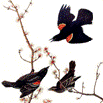Center, Internet, Wildlife Damage Management

Bird Control Seminars Proceedings
Document Type
Article
Date of this Version
10-1983
Citation
Proceedings Ninth Bird Control Seminar, Bowling Green State University, Bowling Green, Ohio, October 4-6, 1983. Ed. William B. Jackson and Beth Jackson Dodd
Abstract
Sunflower achenes impregnated with methiocarb at levels of up to 1,400 ppm were tested as baits to repel blackbirds from ripening sunflowers in 12, 0.8·ha fields at Sand Lake National Wildlife Refuge, Brown County, South Dakota. Cue enhancement in the form of either 4-Aminopyridine (4-AP) impregnated sunflower achenes or blaze-orange marker flags was used in combination with the methiocarb baits. Combined bird damage was an estimated 53% during the 4-week period from first treatment, at the end of anthesis, until termination of the study. In addition, there was no difference in fields with the 4-AP vs. orange flags. The test seemed to be a clear demonstration that baiting with a repellent is ineffecVve under conditions of constant bird pressure which existed at Sand Lake. Furthermore, numerous studies show that redwings readily distinguish food types and treated vs. untreated forms of the same type. Evidently, they also distinguish treated baits from untreated achenes in the sunflower head. This suggests that the seeds to be protected must themselves be treated with the repellent. Presently, this is not possible with methiocarb due to the difficulty in impregnating the husk with a spray. Use of a surface repellent (e.g. tactile) would seem to be one possible alternative.


Comments
Copyright (c) 1983 Michael M. Jaeger, Donald J. Cunningham, Richard L. Bruggers and EdgarJ. Scott